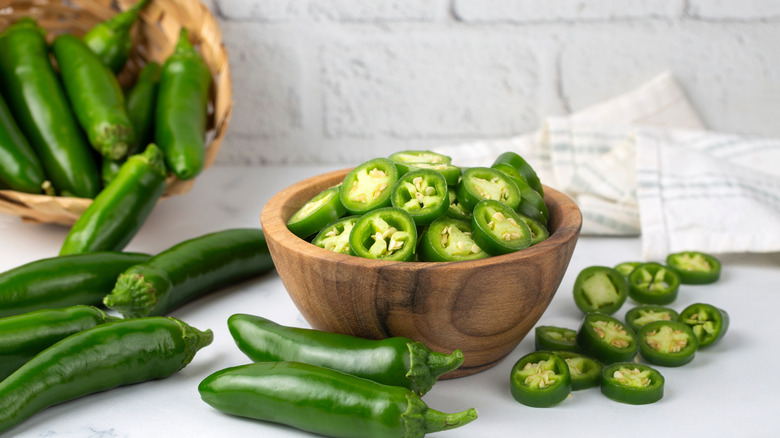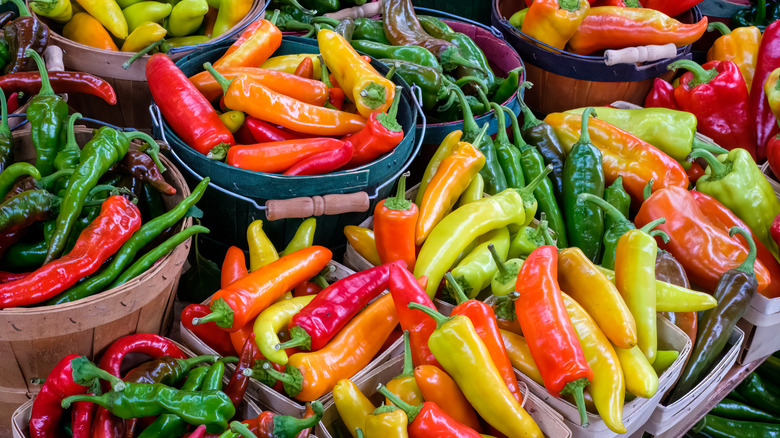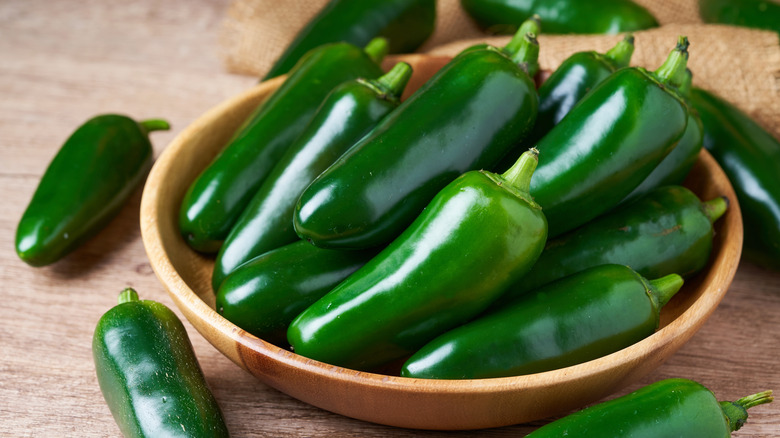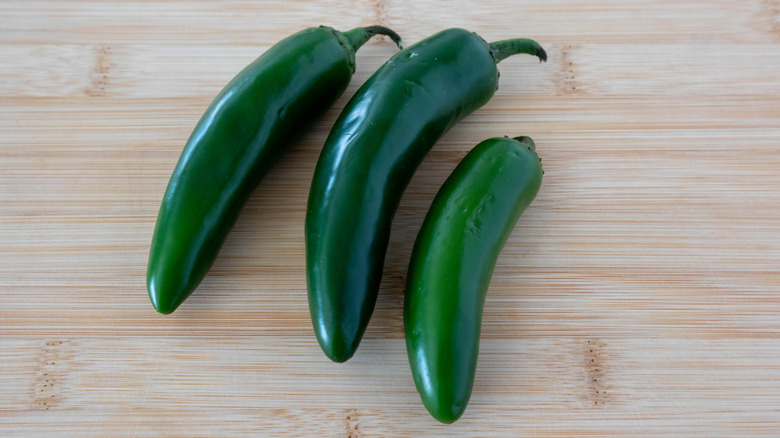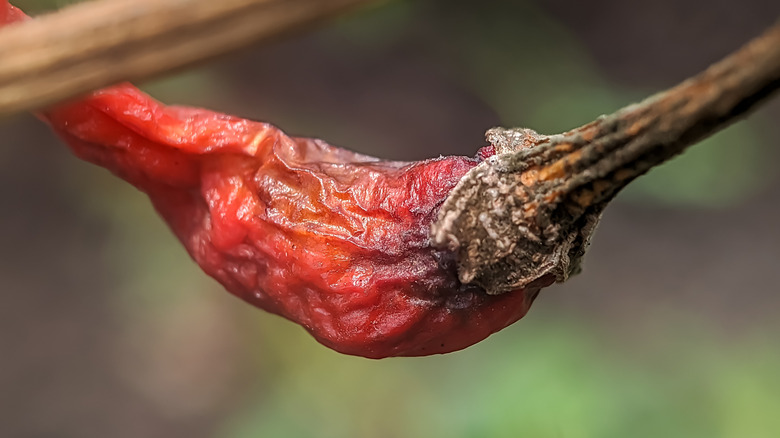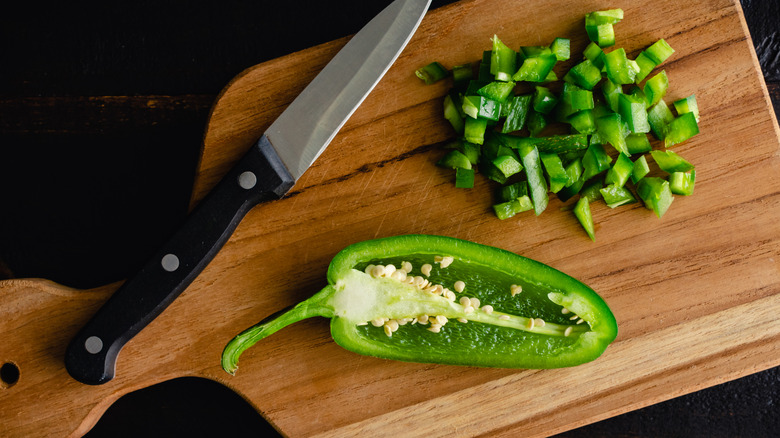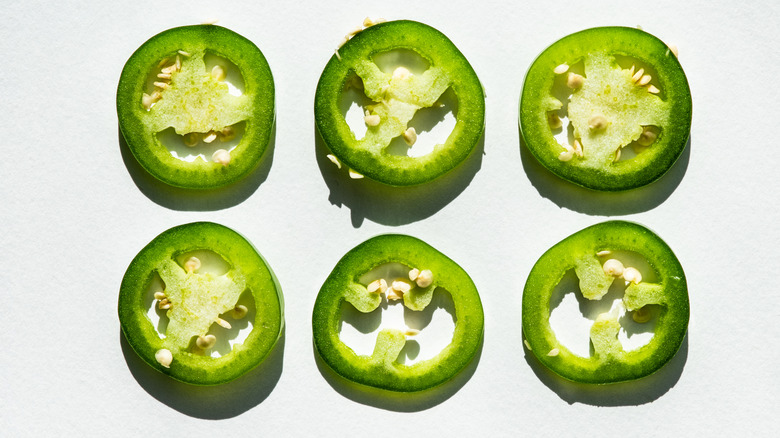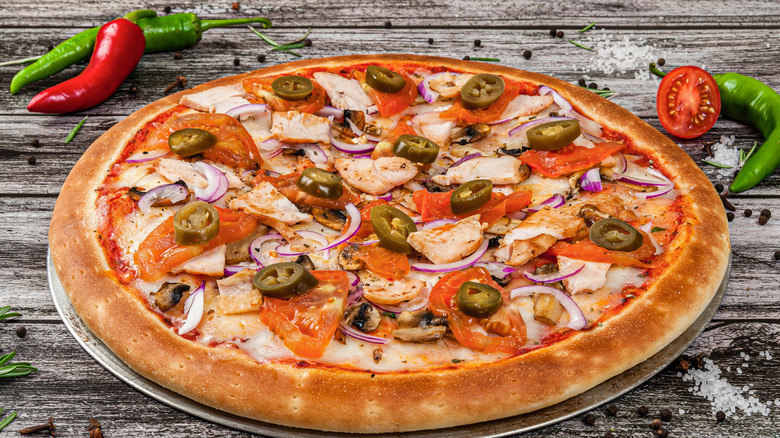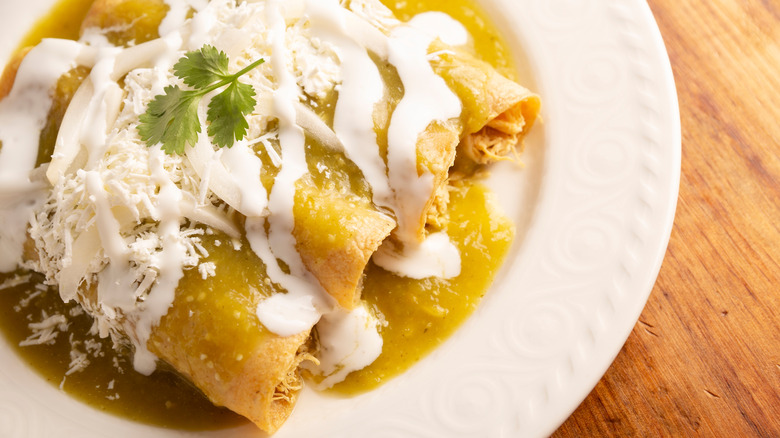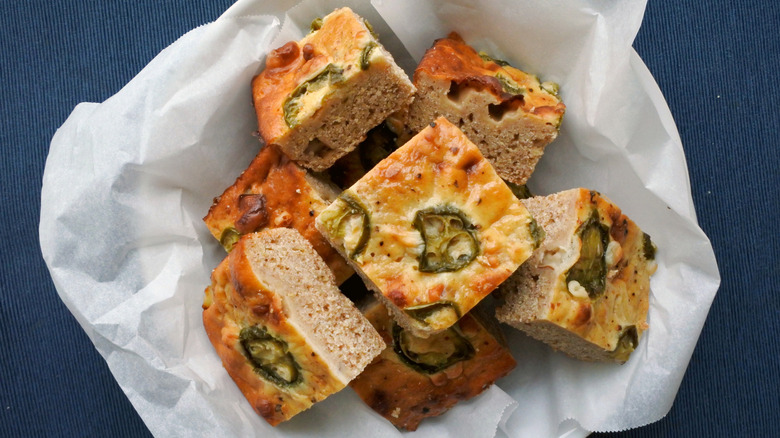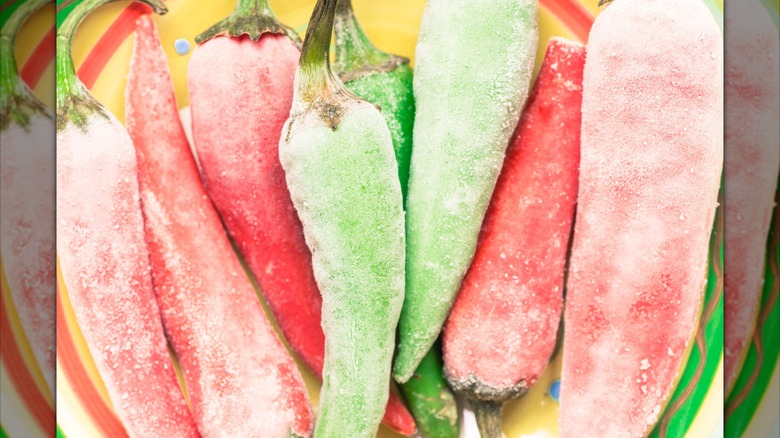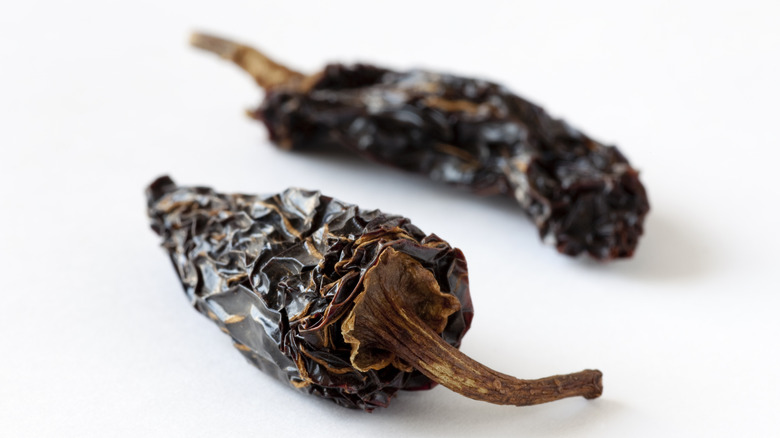Mistakes Everyone Makes With Jalapeños
In a race for the most popular and commonly-used chili pepper, the widely-favored jalapeño would most certainly place. Native to the city of Veracruz, Mexico, jalapeños are believed to have been grown and harvested as far back as 8,000 B.C. by indigenous cultures in the region. Eventually, they were transported by Spanish settlers to other parts of the world, where foreign taste buds accepted them with enthusiasm — and in 2025, jalapeños seem to play a starring role in the cuisine of every foodie corner on the planet. From restaurant dishes to dinners in home kitchens, these sizzling little veggies spice up entrées everywhere.
But despite their popularity, user error continues to persist where jalapeño preparation is concerned. Despite their well-established presence in modern meals, there's still a fair bit of confusion surrounding the fiery ingredient. Whether it's their similarity in appearance to other peppers, or the little-known danger of slicing into them without gloves on, mistakes with one of the world's favorite chili peppers occur more often than you might expect — and we're here to shed some light (or should we say, some heat) over what they are. From color clues to sizzling membranes to lesser-known hacks, here are some common mistakes everyone makes with jalapeños.
Confusing jalapeños for other types of peppers
Relatively small, skinny, green with a stem ... that's a jalapeño pepper, right? Well, yes, but this description can also apply to a number of other peppers in the chili family that can be used to spice up your cooking — and some of them can easily be confused for a jalapeño in the store. Serranos, for example, bear a striking resemblance to the jalapeño: so much so that the internet is alight with articles and guides for helping consumers detect the difference between the two.
Other similar-looking peppers that may get in the way of your intended purchase are Fresnos, spruces, Anaheim chiles, habaneros — even smaller-sized bell peppers. To ensure you get your hands on an actual jalapeño at the market, keep your eyes peeled for a medium-sized, slightly-curved pepper with a thick skin that can be either green or red, depending on its level of ripeness. Studying a guide prior to shopping — in combination with being extra mindful of your particular grocer's labeling — can help you in avoiding this common pepper confusion.
Ignoring a jalapeño's color
Though we tend to think of jalapeños as ever-existing in their popularized green hue, this isn't always the case. Varying shades of green, or even red, can overcome the outer skin depending on each pepper's current stage of ripeness — and, depending on your desired flavor and preferred level of spice, these differences should be taken into account during the pepper selection process.
For example, a dark green or red color indicates a higher level of ripeness — something pointing to a spicier, more robust jalapeño. A light green color, conversely, indicates less ripeness, which equates to lower spice and lesser-developed flavor. Neither of these profiles are better or worse, as you can utilize an under-ripe pepper in the same way you can a ripe one — it's simply a question of requiring more sizzle or less for your recipe or taste buds. In addition to color, striping is another physical aspect to take note of in regard to jalapeño peppers. If the outer skin is marked by white-ish lines that look almost like human stretch marks, this is another accurate indicator of amplified spiciness.
Storing jalapeños on the counter, rather than in the fridge
A bag of apples, a bushel of bananas, a bunch of onions: produce is often brought back from the grocery store and thrown onto kitchen counter tops where it'll most likely remain until consumption. But for those recently-bought jalapeños coming out of your freshly-washed reusable grocery bag, it's worth taking an extra few seconds to clear out some storage space in your refrigerator.
Whole, uncut peppers — jalapeños included — that are stored in the fridge will maintain a much longer shelf-life than those left at room temperature. In the same way that mushy avocados will cease further ripening when thrown in the refrigerator, colder temperatures likewise slow down peppers' natural ripening processes, keeping the growth of bacteria at bay for up to two weeks. Thus, your chilled trove of spicy guys will hold onto their crunchy, non-wrinkled texture, remaining ready for cooking action when you're finally ready to bake them onto that homemade pizza you're planning. More than worth the extra two minutes post-shopping trip, wouldn't you say?
Tossing jalapeños in the trash when wrinkled
It's a fact of life: wrinkled usually means old. In the case of produce, this is especially true, with severely-wrinkled apples and potatoes often considered past the point of being edible by consumers on sight. But for jalapeños, think twice before giving one with a creased appearance up for dead. Wrinkles spread across these popular Mexican peppers are not an automatic sign of inedibility ... and, in fact, they might be an advantageous trait depending on your desired spice level.
At the stage of wrinkling, a jalapeño is likely nearing the end of its ready-to-eat status — but it may not be there just yet. To determine whether or not your pepper is truly rotting from the inside, rely on your sense of smell: a jalapeño ready for the trash will emit an off-putting, mildewy aroma all but guaranteed to make you shrink back. If this is the case, you should definitely toss it — but if it's wrinkled without a gross smell, you can go ahead and use it in that dish you had planned. The aging pepper may have a milder flavor and be less spicy overall (a positive anyway if less heat holds your fancy), but your casserole will be just fine garnished by wrinkly flakes.
Cutting jalapeños without gloves
We're all familiar with the dinner scramble, rushing to get every element of a recipe sliced and diced for the stove or grill top in a timely manner. But though it may be tempting to start cutting into a freshly-purchased chili pepper right away in preparation for that deliciously-spicy jalapeño recipe you have planned, it is imperative that you take one very important step before you start.
Though it may feel like a waste of time during a slightly-stressful meal rush, stopping to throw on a pair of food preparation gloves is imperative prior to starting in on a round of jalapeño slicing if you want to avoid painful burns. Capsaicin, the chemical compound in chili peppers that gives them their quintessential spicy taste, is hyper-concentrated in both the seeds and membranes of jalapeños. The second that you bring your knife down, that compound will begin to run over your hands and fingers, and it can take hours — sometimes even days — for a bad jalapeño burn to subside. It's just not worth it: reach for the gloves and your skin will thank you.
Leaving the membranes intact
While some love the adrenaline rush of a dish so spicy it makes their tongue ache, the majority of eaters are probably seeking a more mild aspect to their dishes: spice with a pleasant kick, but also doesn't knock their palate into next week. If this last applies to you, then be sure to home in on one very important step during preparation — removing the membrane of your freshly-picked jalapeño.
The membrane, also referred to as the pith or the placental tissue, refers to those white-ish stretches of skin running lengthwise down the inside of chili peppers. Along with the seeds, it is one of the areas in which capsaicin, the spicy chemical compound for which hot peppers are known, is most concentrated. While the knowledge to remove the seeds prior to cooking or consuming jalapeños appears to be fairly widespread, the knowledge to remove the membrane seems less so — but it is majorly important if high heat is something you'd prefer to avoid. Just be sure to throw on a pair of protective food-handling gloves before you go digging into the area of the pepper with the largest amount of skin-irritating oils.
Assuming your jalapeño will be ultra-hot
Though many consumers think of jalapeños as being peppers that will light their eyes on fire like an exaggerated cartoon character, in actuality, they are considered one of the tamer members of the chili family from a heat standpoint. Thus, that skinny green pepper on the grocery store shelf may not be the right choice for your meal if fire-eyes is the level of spiciness you're seeking.
Though jalapeños can pack a punch in their own right, if you're looking for some seriously tongue-numbing spice, you may want to opt for a different type of chili pepper. Jalapeños generally only measure between 2,500 to 5,000 on the Scoville Scale, the universal standard for determining the spiciness of peppers, while cayenne, for comparison, comes in at a whopping 30,000 to 50,000. Serrano peppers, ghost peppers, habaneros, and Carolina Reapers all maintain significantly higher Scoville Scale ratings than jalapeños, as well, so don't fall for the trap of believing this common green chili is the end-all, be-all of spiciness. With a slightly different pepper choice, there's a whole other standard of hot to experience — if you dare.
Not pairing jalapeños with dairy, especially if they're too strong
You bite down into a plateful of enchiladas, expecting a well-balanced bite of tortilla, sauce, ground meat, and pleasant hint of the pickled jalapeños you threw into the mix. Instead, however, all you can taste is the blazing flavor of that final ingredient — apparently, it seems, you added a bit more than just a small handful of chili peppers, after all.
Before you deem your overly-spicy dish inedible, however, head to the fridge for that cool tub of sour cream tucked away on the top shelf. Cow's milk and dairy products contain casein protein, a component which naturally binds to the spicy chemical known as capsaicin found in chili peppers, prior to it hitting our tongue. As a result of this binding, less of our body's sensory receptors will be reached, subsequently cutting down on our taste bud's perception of spice. Thus, stirring a dollop of plain yogurt or cottage cheese into that overly-hot plate of enchiladas may save your meal, ultimately reducing food waste. It's a win-win.
Neglecting to use jalapeños for baking
Let's face it: jalapeños have a flavor box, and that box is decidedly savory. These poignant little peppers most often star as a spicy garnish or addition in salty dishes like tacos, pizzas, or quesadillas ... and the rather unorthodox thought of them being included in anything sweet might be something that initially makes you curl your lips in disgust.
But in this case, keep the phrase "don't knock it until you try it" in the forefront of your mind. As it turns out, jalapeños can play a delicious role in sweeter delicacies if you can open your mind to the seemingly-contrasting pairing. A simple search online will reveal a plethora of interesting and boundary-pushing recipes calling for these zingy little veggies, such as jalapeño-and-chili-pepper brownies, honey-jalapeño ice cream — even jalapeño chocolate chip cookies. A great number of dessert treats can be infiltrated (and dare we even say, improved?) with a few chopped or puréed peppers. Life's too short to eat boring desserts, we say, so don't be afraid to go for it with a spicy sweet treat. Who knows? You may just find a new favorite in the process.
Neglecting to freeze jalapeños whole
Do you ever want just a couple flecks of jalapeño shaved over a slice of pepperoni pizza or a cheesy breakfast burrito, but don't want to go to the lengths of putting on gloves, de-seeding, and slicing up a whole one? Look no further than the genius frozen jalapeño hack, which requires nothing more than an ice box to satisfy your spice-craving needs on a time crunch.
Freezing jalapeños in their whole state may seem strange, but it is the perfect way to harness a small amount of flavor from the beloved pepper both quickly and painlessly. Pull a frozen jalapeño out of the freezer, and dig out a cheese grater from the cupboard. Grate the frozen pepper over whatever dish needs a little life breathed into it, and voilà: you've got the perfect instant spicy kick for your Southwestern eggs, molten nachos fresh out of the oven, or zingy margarita cocktail. It's that easy.
Choosing not to dehydrate them
Arguably the most unfortunate aspect of a delicious batch of jalapeño peppers is their limited shelf life. At room temperature, jalapeños will last but a few fleeting days before going bad. If stored in the fridge, this timeline can be extended for up to two weeks — but this still isn't a particularly lengthy timeline where a kitchen is concerned. Never fear, however; the method of dehydration is here to save the day, offering you a way to keep a delicious bunch of peppers in the clear for eating for up to an entire year.
Using a dehydrator to suck the moisture out of sliced or whole jalapeños will render ready-to-eat, crisped peppers perfect for mixing into salads and casseroles, or turning into flakes for sprinkling. In this form, stored in an airtight container somewhere dry and cool, jalapeños can stay good for up to six months to a year. Don't have a dehydrator machine? Don't sweat it — the same effect can be achieved through a lengthy roast in the oven on a low-heat setting. Whichever vessel you decide on for your roasting needs, your long-lasting jalapeño dreams can be achieved — and we certainly hope you get the most out of your next round of sizzling peppers.
